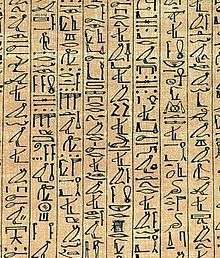Cursive hieroglyphs

Cursive hieroglyphs or hieroglyphic book hand are a cursive variety of Egyptian hieroglyphs commonly used for religious documents written on papyrus, such as the Book of the Dead. It was particularly common during the Ramesside Period and many famous documents, such as the Papyrus of Ani, utilize it. It was also employed on wood for religious literature such as the coffin texts.
Cursive hieroglyphs should not be confused with hieratic. Hieratic is much more cursive, having large numbers of ligatures and signs unique to hieratic. However, there is, as might be expected, a certain degree of influence from hieratic in the visual appearance of some signs. One significant difference is that the orientation of cursive hieroglyphs is not constant, reading right to left or left to right depending on the context, whereas hieratic is always read right to left.[1]
Notes
References
- Cruz-Uribe, Eugene. 2001. "Scripts: An Overview." In The Oxford Encyclopedia of Ancient Egypt, edited by Donald B. Redford. Vol. 3. Oxford, New York, and Cairo: Oxford University Press and The American University in Cairo Press. 192–198 [194–195].
- Davies, W. V. (1990). "Egyptian Hieroglpyphs". In Hooker, J. T. Reading the Past: Ancient Writing from Cuneiform to the Alphabet. Berkeley: University of California Press. pp. 75–136. ISBN 978-0-520-07431-6.
External links
-
 Media related to Cursive hieroglyphs at Wikimedia Commons
Media related to Cursive hieroglyphs at Wikimedia Commons
